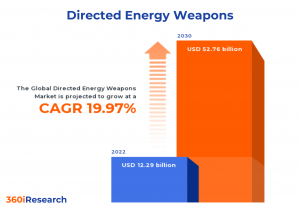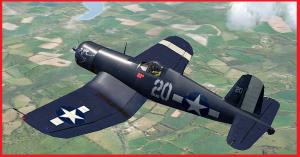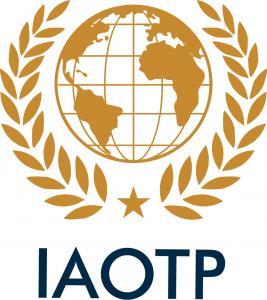The Global Directed Energy Weapons Market to grow from USD 12.29 billion in 2022 to USD 52.76 billion by 2030, at a CAGR of 19.97%.
PUNE, MAHARASHTRA, INDIA, November 9, 2023 /EINPresswire.com/ — The “Directed Energy Weapons Market by Product (Lethal Weapons, Non-Lethal Weapons), Technology (High Energy Laser Technology, High Power Microwave Technology, Particle Beam Weapons), Range, Application, Platform – Global Forecast 2023-2030″ report has been added to 360iResearch.com’s offering.
The Global Directed Energy Weapons Market to grow from USD 12.29 billion in 2022 to USD 52.76 billion by 2030, at a CAGR of 19.97%.
Request a Free Sample Report @ https://www.360iresearch.com/library/intelligence/directed-energy-weapons?utm_source=einpresswire&utm_medium=referral&utm_campaign=sample
A directed energy weapon (DEW) damages its target with approvingly focused energy, including laser, microwaves, and particle beams. Potential applications of this technology include weapons that target personnel, missiles, vehicles, and optical devices. Directed energy operates as a force multiplier, enabling the warfighter to counter a growing range of emerging threats. Rising demand for laser weapons for security across land, air, and sea, new development of directed energy weapons, and the adoption of non-lethal weapons are driving the market growth. Additionally, the armed forces are investing in integrating cutting-edge weapon systems, such as directed energy weapons and onboard vehicles, driving the market’s growth. However, various industry regulations and the design complexity of military DEW systems have been adversely impacting the development of the market. Moreover, governments increasingly focus on military modernization and growing international security concerns to enlarge the defense budgets and military weapon spending to update their military electronic warfare and defensive systems, which are expected to create opportunities in the future.
Product: Consistent need for lethal weapons during critical warfares
Lethal DEWs are high-energy laser systems or particle beam weapons designed for precision targeting, causing irreversible damage to enemy assets. The need for lethal weapons arises from the increased demand for advanced weapon systems capable of neutralizing threats with minimal collateral damage while maintaining a low logistical footprint. Non-lethal directed energy weapons are developed and used to minimize the possibility of delivering fatalities, permanent or effective injuries, or damage to material or infrastructure.
Application: Rising investments in the defense sector to accelerate the production of quality weapons, including DEW
In the defense sector, directed energy weapons (DEWs) are increasingly being adopted due to their precision, speed, and cost-effectiveness. These weapons offer a range of benefits, including reduced collateral damage, increased accuracy against fast-moving targets, and minimal logistical burdens. In homeland security applications, DEWs can provide non-lethal solutions for crowd control and perimeter security. These systems are designed to incapacitate or deter hostile individuals without causing lasting harm, making them a preferred choice for law enforcement and border security operations. While defence-focused DEWs focus primarily on the accuracy and destruction of enemy assets, homeland security DEWs aim to minimize injuries and avoid escalation of conflict.
Platform: Increasing utility of land-based DEWs to ensure protection of ground forces
Airborne DEWs have gained significant traction due to their ability to engage targets at faster speeds and longer ranges than traditional weapon systems. These weapons are mounted on aircraft, helicopters, and unmanned aerial vehicles (UAVs) to provide precision targeting and reduce collateral damage. Land-based DEWs are essential for protecting ground forces and critical infrastructure from various threats, such as drones, rockets, artillery shells, and missiles. Naval DEWs cater to the defensive and offensive requirements of naval platforms such as ships, submarines, and coastal defense systems by providing increased precision, faster engagement times, and lower costs per shot. Space-based DEWs have the potential to revolutionize space warfare by providing global coverage and rapid response capabilities against emerging threats such as anti-satellite weapons or hostile spacecraft.
Technology: Advancements in different kinds of high-energy laser technology to improve accuracy of the weapons
High-energy laser technology is the most advanced concept for a tactical, ground-based defensive laser system capable of being mounted on various air, land, or sea-based platforms. High-energy laser technology includes chemical, fiber, free electron, and solid-state lasers. A chemical laser obtains energy from a chemical reaction, while fiber lasers utilize an optical fiber cable made of silica glass to guide light. High-power microwave technology in weapons creates electromagnetic energy beams over a broad spectrum of radio and microwave frequencies (in narrow and wideband), causing temporary or permanent effects on electronics within targeted systems. A particle-beam weapon utilizes a high-energy beam of atomic or subatomic particles to harm the target by disrupting its atomic and molecular structure. A particle beam comprises charged particles such as electrons, protons, and hydrogen atoms.
Range: Improved functionalities of DEWs above 1 KM range for strategic defense missions
The directed energy weapons can carry potentially destructive amounts of energy, possibly melting or cracking metal under certain circumstances. High-range weapons above 1 km can cause only non-lethal effects, including eye burn, paralysis, and respiratory issues. However, the potentially lethal effects are produced only within 100 meters range, and disruptive effects are at distances of one kilometer.
Regional Insights:
Europe has a significant position in the directed energy weapons market owing to the high military & defense sector investments and technological advancements. Introducing unmanned aerial vehicles (UAVs) armed with missiles and bombs for combat has increased the need for directed energy weapons in Europe. The directed energy weapons market in the Americas is growing, expanding military expenditure and investments in advancing new defense weapons. The Americas is home to well-established companies that are actively engaged in designing cutting-edge DEW systems for various branches of the military sector. The directed energy weapons market in the Asia-Pacific region is growing with the supportive government frameworks and the development in the military & defense sectors. Significant investments are made by countries such as China, South Korea, and Australia to decrease reliance on exports by achieving self-sustenance in developing technologies and equipment necessary for defense and security operations. Asian countries such as China and India are ramping up efforts to develop indigenous DEW capabilities as part of their strategic military modernization initiatives.
FPNV Positioning Matrix:
The FPNV Positioning Matrix is essential for assessing the Directed Energy Weapons Market. It provides a comprehensive evaluation of vendors by examining key metrics within Business Strategy and Product Satisfaction, allowing users to make informed decisions based on their specific needs. This advanced analysis then organizes these vendors into four distinct quadrants, which represent varying levels of success: Forefront (F), Pathfinder (P), Niche (N), or Vital(V).
Market Share Analysis:
The Market Share Analysis offers an insightful look at the current state of vendors in the Directed Energy Weapons Market. By comparing vendor contributions to overall revenue, customer base, and other key metrics, we can give companies a greater understanding of their performance and what they are up against when competing for market share. The analysis also sheds light on just how competitive any given sector is about accumulation, fragmentation dominance, and amalgamation traits over the base year period studied.
Key Company Profiles:
The report delves into recent significant developments in the Directed Energy Weapons Market, highlighting leading vendors and their innovative profiles. These include Applied Companies Corporation, BAE Systems PLC, EaglePicher Technologies, LLC, Elbit Systems Ltd., Electro Optic Systems Pty Limited, Epirus, Inc., General Atomics, Honeywell International Inc., II-VI Incorporated, Kord Technologies by KBR Inc., L3Harris Technologies, Inc., Leidos, Inc., Leonardo S.p.A., Lockheed Martin Corporation, MBDA Missile Systems, Moog Inc., Northrop Grumman Corporation, QinetiQ Limited, Radiance Technologies, Inc., Rafael Advanced Defense Systems Ltd., Raytheon Technologies Corporation, Rheinmetall AG, Roketsan A.Ş., Textron Inc., Thales Group, and The Boeing Company.
Inquire Before Buying @ https://www.360iresearch.com/library/intelligence/directed-energy-weapons?utm_source=einpresswire&utm_medium=referral&utm_campaign=inquire
Market Segmentation & Coverage:
This research report categorizes the Directed Energy Weapons Market in order to forecast the revenues and analyze trends in each of following sub-markets:
Based on Product, market is studied across Lethal Weapons and Non-Lethal Weapons. The Lethal Weapons commanded largest market share of 58.77% in 2022, followed by Non-Lethal Weapons.
Based on Technology, market is studied across High Energy Laser Technology, High Power Microwave Technology, and Particle Beam Weapons. The High Energy Laser Technology is further studied across Chemical Laser, Fiber Laser, Free Electron Laser, and Solid-State Laser. The High Power Microwave Technology commanded largest market share of 46.25% in 2022, followed by High Energy Laser Technology.
Based on Range, market is studied across Less than 1 KM and More than 1 KM. The More than 1 KM commanded largest market share of 78.33% in 2022, followed by Less than 1 KM.
Based on Application, market is studied across Defence and Homeland Security. The Defence commanded largest market share of 87.66% in 2022, followed by Homeland Security.
Based on Platform, market is studied across Airborne, Land, Naval, and Space. The Land commanded largest market share of 39.12% in 2022, followed by Naval.
Based on Region, market is studied across Americas, Asia-Pacific, and Europe, Middle East & Africa. The Americas is further studied across Argentina, Brazil, Canada, Mexico, and United States. The United States is further studied across California, Florida, Illinois, Maryland, Massachusetts, New York, Ohio, Pennsylvania, Texas, and Virginia. The Asia-Pacific is further studied across Australia, China, India, Indonesia, Japan, Malaysia, Philippines, Singapore, South Korea, Taiwan, Thailand, and Vietnam. The Europe, Middle East & Africa is further studied across Denmark, Egypt, Finland, France, Germany, Israel, Italy, Netherlands, Nigeria, Norway, Poland, Qatar, Russia, Saudi Arabia, South Africa, Spain, Sweden, Switzerland, Turkey, United Arab Emirates, and United Kingdom. The Americas commanded largest market share of 39.89% in 2022, followed by Europe, Middle East & Africa.
Key Topics Covered:
1. Preface
2. Research Methodology
3. Executive Summary
4. Market Overview
5. Market Insights
6. Directed Energy Weapons Market, by Product
7. Directed Energy Weapons Market, by Technology
8. Directed Energy Weapons Market, by Range
9. Directed Energy Weapons Market, by Application
10. Directed Energy Weapons Market, by Platform
11. Americas Directed Energy Weapons Market
12. Asia-Pacific Directed Energy Weapons Market
13. Europe, Middle East & Africa Directed Energy Weapons Market
14. Competitive Landscape
15. Competitive Portfolio
16. Appendix
The report provides insights on the following pointers:
1. Market Penetration: Provides comprehensive information on the market offered by the key players
2. Market Development: Provides in-depth information about lucrative emerging markets and analyzes penetration across mature segments of the markets
3. Market Diversification: Provides detailed information about new product launches, untapped geographies, recent developments, and investments
4. Competitive Assessment & Intelligence: Provides an exhaustive assessment of market shares, strategies, products, certification, regulatory approvals, patent landscape, and manufacturing capabilities of the leading players
5. Product Development & Innovation: Provides intelligent insights on future technologies, R&D activities, and breakthrough product developments
The report answers questions such as:
1. What is the market size and forecast of the Directed Energy Weapons Market?
2. Which are the products/segments/applications/areas to invest in over the forecast period in the Directed Energy Weapons Market?
3. What is the competitive strategic window for opportunities in the Directed Energy Weapons Market?
4. What are the technology trends and regulatory frameworks in the Directed Energy Weapons Market?
5. What is the market share of the leading vendors in the Directed Energy Weapons Market?
6. What modes and strategic moves are considered suitable for entering the Directed Energy Weapons Market?
Mr. Ketan Rohom
360iResearch
+1 530-264-8485
email us here
![]()
Originally published at https://www.einpresswire.com/article/667381033/directed-energy-weapons-market-worth-52-76-billion-by-2030-exclusive-report-by-360iresearch




